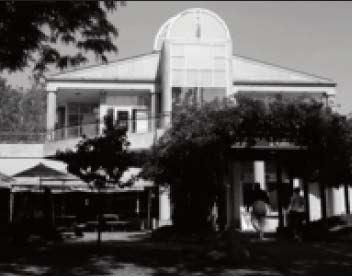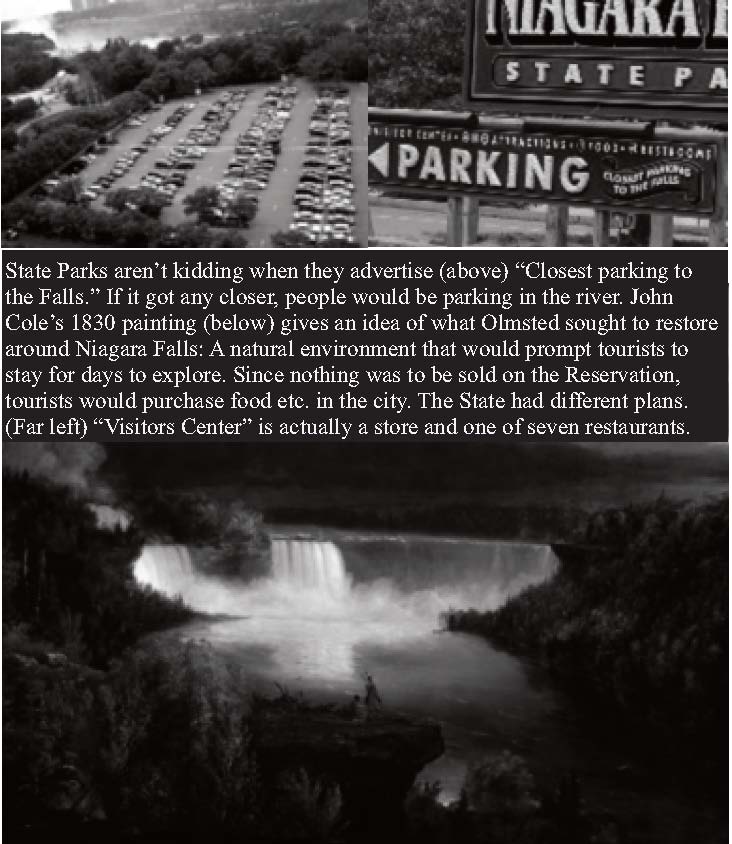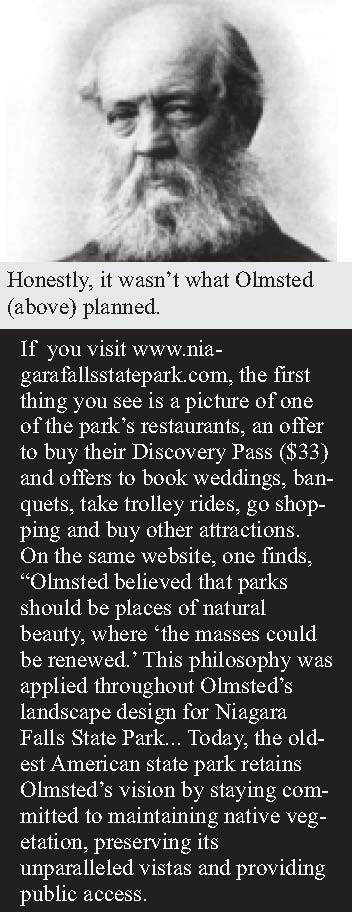AS IT VEERS FROM OLMSTED, IS STATE PARK FRIEND OR FOE?
By Frank Parlato
 Today, the Niagara Falls State Park operates almost exactly opposite to the original plan for which it was created as America’s first state park. In many ways, the Park has served not to help the city of Niagara Falls but as competition against it.
Today, the Niagara Falls State Park operates almost exactly opposite to the original plan for which it was created as America’s first state park. In many ways, the Park has served not to help the city of Niagara Falls but as competition against it.
In 1868, Frederick Law Olmsted, along with others, began the movement to establish the Niagara Reservation. At the time, the banks of the American rapids included a grist mill, stable, and pulp mill. Prospect Point had a pavilion where people came to drink and dance. There were plans to make a housing subdivision near the brink of the falls. Goat Island was targeted for a race-course, a rifle range and a row of factories. Next to the falls there were gaudy stores and restaurants.
Olmsted, who designed Central Park and helped preserve Yosemite, conceded these developments did not reduce the grandeur of the falls. But the scenery of Niagara depended on more than the falls. It included the rapids and foliage. He wished to preserve those lands.
In 1883, Gov. Grover Cleveland signed a bill "to preserve the scenery of Niagara Falls." In 1885, the reservation was established.

Olmsted and partner, Calvert Vaux, prepared the "General Plan for the Improvement of the State Reservation at Niagara," in 1887. Olmsted made an important observation, one that is significant today as the city grapples with why tourists stay for such short visits, compared to other destinations, and spend so little money in the city. Recalling a time before there was development adjacent to the falls, Olmsted noted visitors came for days, exploring on foot, visiting and revisiting favorite spots and postponing their departure while immersing themselves in nature.
By 1887, he noted, when almost anywhere one looked, one saw commerciality and visitors came for only one day to be "put through" the sights in carriages. They still saw spectacular views of the falls, but experienced little of the beauty near the falls, a "beauty of a kind, depending on refinement and delicacy, and subtle qualities of natural elements of scenery, and these largely apart from the actual cataract."
"Of illumined spray and mist and fleeting waters,” he wrote of, “and of intricate disposition of leaves, with infinitely varied play of light and shadow, refractions and reflections, and much else that is un-definable in conditions of water, air and foliage."
Olmsted’s plan was to reserve the land around the falls, to frame the falls, and, in his plan, he excluded from the park all structures for activities, including restaurants. The purpose was to allow undisturbed enjoyment of the rarest scenery that would in turn lead to “pensive contemplation” and appreciation of nature, without man-made or commercial interests.
"It may be safely assumed," Olmsted wrote, "that no improvement that the State can make will increase the astonishing qualities of Niagara."
 Goat Island especially was to be a place for walking, since only by exploring on foot could visitors experience its unparalleled charm.
Goat Island especially was to be a place for walking, since only by exploring on foot could visitors experience its unparalleled charm.
Any offer to place a costly object of art, such as a large statue, on the island, Olmsted wrote, should meet with as firm a refusal as an offer "to stock the Island with poison ivy or with wolves or bears."
Olmsted focused on reclaiming scenic areas and establishing walks and managed views, while protecting the natural character of each area.
At first, the park operated as Olmsted planned. However, the history of the park since World War II has been largely to ignore his plan. A four-lane expressway obliterated much of the original landscaping along the banks of the rapids. A metal and glass elevator shaft and observation deck was built. A steel highway bridge to Goat Island was built where it mars Olmsted’s best view of rapids. Goat Island lost much of its forest beauty. Statues, souvenir stores, restaurants and flower beds changed his park.
Olmsted's plan called the prohibition of restaurants "a cardinal necessity (for) success" of the plan.
He wrote, "If it were a commercial undertaking into which the State was entering, in competition with the people of the village of Niagara, it cannot be questioned that the restaurant could be made profitable."
Today, seven restaurants, numerous stores and many other attractions make the park perhaps the largest tourist business in Niagara Falls. Most state parks are not ‘big business’ but support local business.
The state built the Robert Moses Parkway. It cut off public access to the gorge and destroyed part of Olmsted’s original reservation, and aids park business by speeding tourists away from the city, directly into the park,
Olmsted’s plan was there was to be no land in the park set aside for (carriage) parking, "because at best many trees must be destroyed." By 1987, Albany clear-cut acres of trees to create 900 paid parking spaces. Formerly tourists parked in the city.
Today, the park has assumed the quality of a souvenir and restaurant business, with a paid parking lot and, of course, a water feature.
A typical tourist drives along the state-owned Robert Moses Parkway into the state lot and pays $10 for parking. Then goes to the Maid of the Mist: $15.50 and exits through the Maid of the Mist Souvenir Store. He eats at restaurants in the park, visits gift stores, rides paid trolleys, and pays for a trip down the Cave of the Winds ($11). Because the park is small, with limited parking, when the season is at peak, and because there seems little to do in the city, tourists often stay a few hours, then leave town, perhaps for Canada, spending every dollar in the park, not setting foot in the city.
With much of the natural elements gone and no place where you can turn and not see commercial interests, there is little remaining of Olmsted’s plan. The chance to explore nature for days as Olmsted planned is gone. But the money earned by the State Park far exceeds what Olmsted could have generated. It is sent to Albany where it helps support parks in New York City.